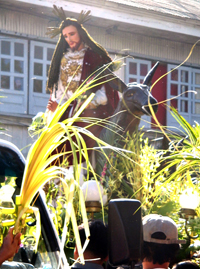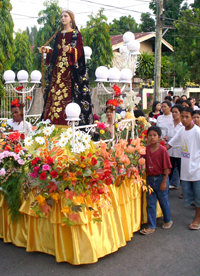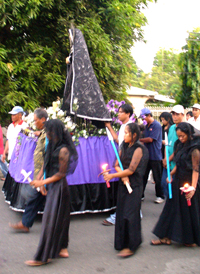Devotion: A glimpse of Lenten practices

Domingo de Ramos
Lent is celebrated with deep prayer, reflection, meditation, and renewal of Christian practices such as Stations of the Cross, benediction, perpetual adoration of the Blessed Sacrament and saying the rosary
Traditionally, in the Philippines, throughout the Season of Lent, parishes experience rich and diverse devotional practices rooted in traditional ethnic practices. Among the Lenten devotions of various ethnic groups are those that venerate the Crucified Christ, particularly on Fridays.
Lent is celebrated with deep prayer, reflection, meditation, and renewal of Christian practices such as Stations of the Cross, benediction, perpetual adoration of the Blessed Sacrament and saying the rosary. Such devotions are a useful preparation for the celebration of the Lord's Passion and Death in Holy Week. Acts such as kissing of the cross, traditional singing and dramatization of the story on the passion of Christ, blessing of the palms on Palm Sunday, the Holy Thursday ritual of washing the feet, the Good Friday vigil and Easter are devotional exercises encouraged to help foster the liturgical spirit with which the faithful can prepare themselves for the celebration of Christ's paschal mystery.

Annual Procession
People are notably involved in the rites of Holy Week. Many of them still bear the traces of their origins in popular piety.
Holy Week begins with Domingo de Ramos or Palm Sunday. A procession of Christ riding a donkey is joyous and popular in character. Catholics keep palm branches that have been blessed on Palm Sunday in their homes or in their work places. Palms branches are kept in the home as a witness to faith in Jesus Christ.
Passion processions are undoubtedly the most popular and important. The procession of the life-size Lenten images is usually conducted in austere silence, prayer, and the participation of many of the faithful, who feel much of the significance of the Lord's burial.
Another popular practice among the faithful is the Via Crucis popularly known as the Station of the Cross with its origin in medieval processions between churches commemorating the various stages of Via Dolorosa or the Dolorous Journey of Christ. It is the custom of the faithful to follow the way walked by Christ from Pilate's house in Jerusalem to Calvary. This devotion has consisted of fourteen stations that have been arranged around the walls of the nave of the church, or, in some instances, around the gathering space or even the exterior of the church, marking the devotion as a true journey. In the town of Sta. Barbara, 15.6 kilometers away from the city, during Good Friday, an annual Kapiya contest is being undertaken. The 14 Stations of the Cross are fully-decorated and well-lighted life-size images of Lenten characters made from indigenous materials.

Annual Procession
A continuing ritual is the singing of the account of the Sacred Passion of Christ, locally known as Pasion or Pasyon. A popular Lenten tradition among Catholic Filipino families, this is a practice of continued singing, taking 18-20 hours without disruption from start to finish. The song recounts the life of Christ with commentaries and moral lessons and ends with verses that encouraged everyone to follow the teachings of Christ and to model one's life after him. It also speaks of sin and the punishment of hell. The passion book used, normally of 213 pages is written in two-column verse format. Singers take turn taking breaks as the host makes sure that there is a continuous supply of food for the singers and guests. The traditional singing of the pasyon is called Pabasa or reading. For most Filipinos, participating in this practice is an act of worship and a fulfillment of a panata or a vow to supplement a petition to God or as a form of thanksgiving. The municipality of Cabatuan, a central town 24.2 kilometers away from the city holds their annual pasyon contest every Good Friday.
While most not only sing the passion, others act it out as well. Although commonly edited and revised, the passion play, locally known as a Senakulo, is based on the passion. During Good Fridays, in the northern town of Barotac Viejo, 60.4 kilometers away from the city, the dramatic re-enactment of the crucifixion of Christ locally known as the Taltal is staged in the whole town with designated places for specific scenes.
The ritual of washing the apostles' feet and the reenactment of the last supper, locally known as Cordero on Maundy Thursday is a popular practice in the southern town of Miag-ao, 40.5 kilometers away from the city. The towns' parish priest with 12 males that represents the apostles eats together in the home of the hermano and hermana.
Celebrated on Easter Sunday, the town of Leganes, Oton, and Alimodian are popular destinations for the reenactment of Salubong or the meeting of the life-size statues of the Blessed Virgin Mary (wearing a black veil) and the risen Christ. Towed separately and followed by people through the streets, the mahogany-colored images are made to meet at a specified place in the town. A Dampog follows where a child dressed as an angel and commonly suspended from the stage erected, removes the Blessed Virgin's black veil of mourning and a white veil is revealed as a symbol of Christ' resurrection.
